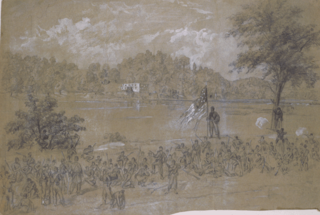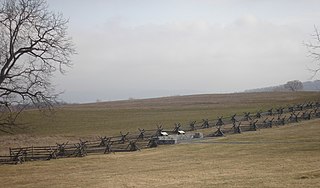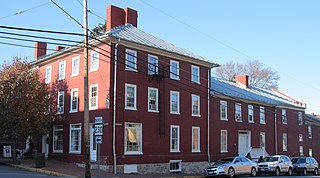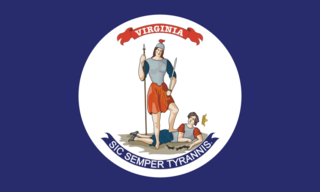
Harpers Ferry, population 286 at the 2010 census, is a historic town in Jefferson County, West Virginia, United States, in the lower Shenandoah Valley. It is situated at the confluence of the Potomac and Shenandoah rivers, where the U.S. states of Maryland, Virginia, and West Virginia meet. It is the easternmost town in West Virginia and during the Civil War was the northernmost point of Confederate-controlled territory. It has been called, speaking of the Civil War, "the best strategic point in the whole South".

Shepherdstown is a town in Jefferson County, West Virginia, located in the lower Shenandoah Valley along the Potomac River. Home to Shepherd University, the town's population was 1,734 at the time of the 2010 census.

Shepherd University is a public university in Shepherdstown, West Virginia. The university currently enrolls 4,041 students.

The Battle of Shepherdstown, also known as the Battle of Boteler's Ford, took place September 19–20, 1862, in Jefferson County, Virginia, at the end of the Maryland Campaign of the American Civil War.

Antietam National Battlefield is a National Park Service-protected area along Antietam Creek in Sharpsburg, Washington County, northwestern Maryland. It commemorates the American Civil War Battle of Antietam that occurred on September 17, 1862.

The 1st West Virginia Infantry Regiment was a three-year infantry regiment that served in the Union Army during the American Civil War.

Alexander Robinson Boteler was a nineteenth-century planter turned businessman, as well as artist, writer, lawyer, Confederate officer, philanthropist and politician from Shepherdstown in what was initially Virginia and became West Virginia in the American Civil War.

Rumsey Hall, also known as the Entler Hotel, is an historic building in Shepherdstown, West Virginia. The building is located in the center of the Shepherdstown Historic District and is a composite of six separate phases of construction. The earliest portion was built in 1786, and was the home belonging to Christian Cookus. This section burned in 1912. This section was separated by a narrow passage from the core of the hotel property, first started in the 1790s by owner Daniel Bedinger. This Federal style structure was expanded to the corner sometime before 1809, with a further addition along Princess Street by 1815. A kitchen and a carriage house completed the complex. Significant interior features remain. In 1809 a store was opened in the corner building, operated by James Brown. At about the same time, the Globe Tavern opened, offering overnight accommodations. In 1815, Bedinger sold the property to James Brown and Edward Lucas for $6,000. In 1820 it was again sold, to Thomas Crown of Washington, D.C., for $4000. By this time the tavern was managed by Thomas James and the hotel by Daniel Entler. In 1823, Daniel Entler became the manager of the entire property. The Entlers managed the properties until 1873, when they moved to Piedmont, West Virginia, while retaining ownership of the hotel.

The Shepherdstown Historic District comprises the historic core of Shepherdstown, West Virginia. The town is the oldest in West Virginia, founded in 1762 as Mecklenburg. No structures are known to exist from the time before the town became known as Shepherdstown. The historic district is concentrated along German Street, the main street, with 386 contributing resources and 69 non-contributing elements. The chief representative period is the late 18th century, with many Federal style brick houses. German Street is also furnished with 19th-century "street furniture" such as metal fences, mounting blocks, wooden pumps and mature trees.

The Conrad Shindler House is a historic building, now home to the George Tyler Moore Center for the Study of the Civil War, in Shepherdstown, West Virginia.

The 7th Virginia Infantry Regiment was an infantry regiment raised in Virginia for service in the Confederate States Army during the American Civil War. It fought mostly with the Army of Northern Virginia.

The 13th Virginia Infantry Regiment was an infantry regiment raised in central and western Virginia for service in the Confederate States Army during the American Civil War. It fought mostly with the Army of Northern Virginia.

The 59th Virginia Infantry Regiment was an infantry regiment raised in Virginia's western counties for service in the Confederate States Army during the American Civil War. It fought mostly with the Army of Northern Virginia, and in the Carolinas.

The 62nd Virginia Mounted Infantry Regiment, raised in Virginia for service in the Confederate States Army during the American Civil War, served in many capacities including the war, including as an infantry regiment, a cavalry regiment, a mounted infantry (dragoon) unit, a partisan unit of rangers, and even as a combined arms unit. It fought mostly with the Army of Northern Virginia and in western Virginia. The men were recruited primarily in the counties of Hardy, Hampshire, Barbour, Pendleton and Pocahontas in West Virginia and Augusta and Highland in Virginia .

The 10th Virginia Cavalry Regiment was a cavalry regiment raised in Virginia for service in the Confederate States Army during the American Civil War. It fought mostly with the Army of Northern Virginia.

The 11th Virginia Cavalry Regiment was a cavalry regiment raised in Virginia for service in the Confederate States Army during the American Civil War. It fought mostly with the Army of Northern Virginia.

The 14th Virginia Cavalry Regiment was a cavalry regiment raised in Virginia for service in the Confederate States Army during the American Civil War. It fought mostly with the Army of Northern Virginia.

The 17th Virginia Cavalry Regiment was a cavalry regiment raised in Virginia for service in the Confederate States Army during the American Civil War. It fought with the Army of Northern Virginia, in southwestern Virginia, and in the Shenandoah Valley.

The 23rd Virginia Cavalry Regiment was a cavalry regiment raised in Virginia for service in the Confederate States Army during the American Civil War. The regiment was recruited primarily in the counties of Hampshire, Hardy, Morgan, Berkeley, Frederick, Clarke, Shenandoah, Warren, Rockingham, Augusta, Allegheny and Henrico. It fought in the Shenandoah Valley.

The Wise Artillery was an artillery unit with the Confederate States Army during the American Civil War.














